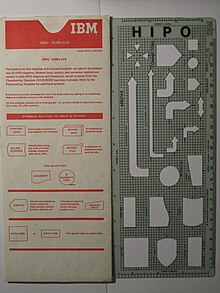
HIPO model (hierarchical input process output model) is a systems analysis design aid and documentation technique from the 1970s, used for representing the modules of a system as a hierarchy and for documenting each module.
History
It was used to develop requirements, construct the design, and support implementation of an expert system to demonstrate automated rendezvous. Verification was then conducted systematically because of the method of design and implementation.
The overall design of the system is documented using HIPO charts or structure charts. The structure chart is similar in appearance to an organizational chart, but has been modified to show additional detail. Structure charts can be used to display several types of information, but are used most commonly to diagram either data structures or code structures.
See also
References
- IBM Corporation (1974).HIPO—A Design Aid and Documentation Technique, Publication Number GC20-1851, IBM Corporation, White Plains, NY, 1974.
- Katzan, Harry Jr. (1976). Systems Design and Documentation: An introduction to the HIPO Method. Van Nostrand Reinhold. ISBN 0-442-24267-0.
- ^ Sandia National Laboratories (1992). Sandia Software Guidelines Volume 5 Tools, Techniques, and Methodologies Archived 2009-08-25 at the Wayback Machine SANDIA REPORTS 85–2348qUC–32
- Mary Ann Goodwin and Charles C. Robertson (1986). EXPERT SYSTEM VERIFICATION CONCERNS IN AN OPERATIONS ENVIRONMENT. NASA paper N88-17234.